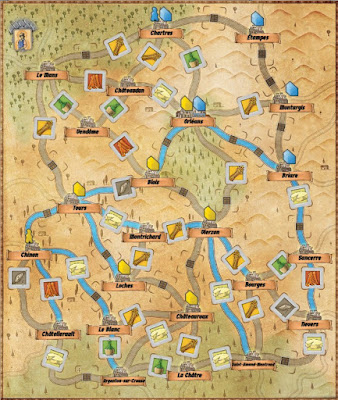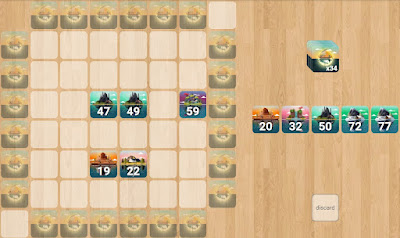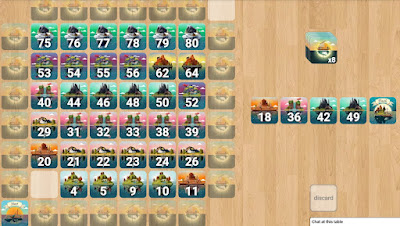Saturday, 5 July 2025
Pinocchio is released!
Friday, 4 July 2025
Orleans
The Game
Orleans is a bag-building game from 2014. That was an era not long after Dominion the pioneer deck-building game was released in 2008. Bag-building, mechanism-wise, is the same thing. It’s just that the physical components are different. In Orleans, instead of cards in a deck, you have chips in a bag. Poker chips, not potato chips. Chips are workers of different types. Every round you draw a number of chips from your bag and use them to perform actions. Once they are done, they go back to the bag.
One aspect of the game is a map showing towns around Orleans. You have a pawn on the map and you can travel about to claim goods and to build trading posts. Goods are worth points at game end, and trading posts too.
The game is played over 18 rounds, and events happen every round, sometimes causing trouble and sometimes presenting opportunities. That’s another aspect you have to handle.
The Play
The game gives you many strategic options - which kind of workers to go for, any buildings which you want to get, how do you travel on the map, which of the tracks to pursue. It’s interesting to manage your pool of workers. You want to tune your worker mix to best serve your strategic direction. Sometimes your needs change and you need to tune again.
Competition comes in many aspects. You race to grab buildings. On the tracks there are spots offering citizens (which help with map scoring) and you need to race to grab them. Movement on the map is a race too, because there are plenty of goods tiles to be picked up by whoever passes by first. There is a finite number of workers of each type. It is possible that they run out and you can't recruit any more. That's another thing you race for.
Thursday, 3 July 2025
Asian Board Games Festival Malaysia 2025
Wednesday, 2 July 2025
Ginkgopolis
Tuesday, 1 July 2025
My string of failures
Most of the games I publish are failures. That sounds weird, and clickbait-like, but it's true. Dancing Queen should be considered a success, because Matagot picked it up and published an international edition. But this was later. In 2021 I designed Dancing Queen because I signed up for a game design competition on BGG. Winning that competition was a huge boost to my confidence level. And maybe to my recklessness too. I tried to submit the game to some publishers who make card games, to no avail. So I decided to publish it myself. I must admit this is an ego trip. And this was how my indie design studio and publisher Cili Padi Games was born.
A sensible person who goes into game design is not doing it for money. Making money from designing games has an extremely low success rate. If you ask me to invest in a start-up game design and publishing house, I'll just say no without asking. That's not called investing. That's charity. We design games because of the ego trip. To phrase it more positively, this is how we explore meaning in life. Creation is an exploration of meaning and purpose. Starting a small indie publisher and printing your own game is not prohibitively expensive. The barrier of entry is low, even if the success rate is miniscule. We do it simply because we want to see our design published. We are spending money, time and energy to fulfil a dream. I want to be honest with myself on this.
I was lucky that Dale Yu from the Opinionated Gamers, one of the top boardgame bloggers in the world, liked Dancing Queen and recommended it. That was how it got picked up by Matagot. It became my first game published internationally by an established boardgame publisher. In the past few years I have been taking part in game design competitions and pitching my games to publishers. I did not have much success. In competitions my games brought home consolation prizes at best. One moderate achievement was Taking Sides (later renamed to Rebels of the Three Kingdoms) getting through to the second round of the Hippodice game design competition. I take part in competitions as a strategy for marketing my games and myself. If I can win something, I can use that as a selling point. Just like Dancing Queen. In the larger and better run competitions, another benefit is getting feedback from experienced game designers and players. At some of the smaller competitions, sometimes I have doubts about the judges. How well are they judging the entries? There was one particular incident I was quite disappointed about. One of the judges admitted that one of the winning games had weak gameplay, but it was pretty. This goes against my belief about game design competitions. A game design competition should be about game design, not art and graphic design. Yes, a published game must have good art, professionally done. That's the minimal industry standard. But this is a game design competition.
I have learned to not get too fixated about competition results. People's tastes in boardgames can be very different. A judge not liking my game may not necessary mean my game is bad. It might. Or it might not. Or maybe I'm just sour grapes. I should spend more time comparing my games with the winning games to see how I can do better. Or differently. If I want to win competitions, it is not only about making a good game. It is about making a game the judges like.
I have also learned to be less fixated about failing to pitch to publishers. When accepting pitches, publishers have so many games to vet through, to be able to catch their attention requires your game to have something that stands out. There are many reasons why a publisher is not interested in your game. It can be because they already have a similar game. Or they do not want to go into this genre. Or their hands are full for the next 12 months. It's not only about whether the game itself is good. I had tried to pitch Ali Baba and the Forty Thieves to a publisher. That didn't work out, so I published it myself. Pinocchio is a game that other publishers didn't want, and it didn't even survive the first round in a competition. Rebel of the Three Kingdoms will likely be my 2026 project. I had wanted to pitch that to a publisher too, but that didn't work out either. So I have to do it myself. This is my string of failures.
One good news is Malaysian Holidays. This is a game I successfully pitched to a publisher. This is my second game which found a publisher. I am very excited about it.
In addition to rejection at competitions and when pitching to publishers, another type of rejection I need to learn to accept is from the reviewers. This type is a little easier to handle. I know games is a very personal thing. People have different tastes and preferences. I have been told my games are dull, lack control, too mathy, and overly simplistic. While I learn to not be discouraged by negative feedback, I also understand the importance of learning from them. If different people give me the same negative feedback, they are probably right and I should make improvements. In fact, every negative feedback is right, in that it reflects what that person feels about the game.
Some do enjoy my games. It always make me happy when I meet someone and they tell me they've played Dancing Queen before and they think it's great.
The boardgame industry doesn't need more game designers or game publishers. We have more than enough. Looking at the number of games published every year, we know no one can play them all. Even if you skip all the mediocre and poor games, there are already more good games than you can ever finish playing. The world doesn't need designers to do designing. It is the designers who need to do designing. We need this dream. It is purpose. It is meaning.
Keep hustling and learning.
Monday, 30 June 2025
Defuse
Sunday, 29 June 2025
DNP Game Design Competition
Before we decided to do this, I asked Jon what our objective was. We spent some time discussing and agreeing on this. We should not be starting any project when the objective has not been clearly defined. Our objective is to encourage more people to get into game design. I want to discover game design talent. We want Malaysia to produce more games and better games. Game design and publishing in Malaysia is in its infancy. We don't have anything we can be particularly proud of that captures global attention. There is much space for growth. We are organising the competition under the MBD label.
As Jon and I planned, the two biggest challenges we expected were money and participants. Organising a game design competition in Malaysia is not profitable. There is little publicity to be gained. Any sponsor will just be doing charity work to support local game design. You don't really need a huge sum of money, but when you are giving money away, even with a small sum you'd wonder why you are parting with your money. Is it really worthwhile? Thankfully both the potential sponsors Jon approached were willing to support the competition. So money was settled. Jon and I had mentally prepared ourselves that we might have to fork out some money. The other big challenge is the number of participants. If we only have a handful of participants, we would not be achieving our goal. During the registration period (the month of May), Jon spent some money on Facebook to get the word out. We want people to know about this competition. We the judges also reached out to our respective circles to promote this competition. When registration closed at the end of May, we had 110 participants. This was amazing! It far exceeded my expectations. Earlier on when Jon and I discussed this, I asked if we had fewer than 20, would we still go ahead with it? I said we must set a go-no-go condition. This was the project manager in me talking.
It is wonderful that we managed to get 110 participants. This also means the judges are going to have a lot of work. In the first stage of the competition participants must submit a rulebook and a short video giving an overview of the game. Every entry will be scored by at least three judges. That means every judge must score at least 55 entries. Eight participants will advance to the second stage (also the final stage). They are required to submit their physical game prototypes, and the judges will sit down to play these games. The deadline for Stage 1 is end of July. In the first half of August we the judges need to complete our scoring, so that the eight finalists will be able to ship their games to us before the end of August. The first half of September will be playtesting and judging of the finalist games. We plan to announce the results on 16 September, Malaysia Day. This is fitting, because the theme for the competition is Malaysia.
There is a reason we chose Malaysia to be the theme for the competition. The prize for the competition is getting your game published. In case you don't want it, you can convert that to a cash prize of MYR 1000. We wanted to make sure the prize is attractive enough to make people want to spend the effort designing a game. It is motivating to have your game getting published for real. We chose Malaysia as the theme and as a requirement because if we were going to publish the winner, we wanted the game to be something Malaysians are familiar with and would accept easily. Being a publisher means making marketable products that many people want, not art pieces that only a handful of people appreciate. One other criteria for the game design is it must have at most 52 cards. This is to control production cost and manageability, and also a card game is generally simpler and easier to learn than a boardgame.
After the registration deadline, we set up a WhatsApp group, inviting all participants. We encouraged them to share their ideas, their rulebooks, and to exchange ideas. Several have already shared their rulebooks and also obtained feedback. Writing rulebooks is difficult, more so than most people realise. People often complain when they read rulebooks, because they are impatient. They don't realise how much effort has gone into making the rulebook as easy to read as possible, and complete, and unambiguous. When learning to become a good game designer, engaging with fellow designers and learning from one another are immensely helpful. I hope this little community of game designers will continue to be active after the competition, and we can develop more and more game designers, and better game designs from Malaysia.
2025 is the first time we are doing the DNP competition. I hope it creates a significant impact that continues to be felt after the competition. I hope this will continue year after year, and help Malaysia find its mark in game design.
Saturday, 28 June 2025
Tranquility
Friday, 27 June 2025
Behind the scenes: Dancing Queen
The international edition of Dancing Queen is now out, from French publisher Matagot. This year, I am also releasing a Malaysian second edition. It uses the original art from the 2022 first edition. The international edition has different art. Unlike the first edition which was manufactured in Malaysia, this second edition is manufactured in China, with Magicraft. They have been my manufacturing partner since Snow White and the Eleven Dwarfs. There are only minor changes in the second edition. Instead of a custom tuckbox, I now use a standard two-piece box. It is sturdier. The cards won't come pre-sleeved anymore. That was a bit too much work when my interns and I did this sleeving. There will be rules in English, Traditional Chinese and Simplified Chinese. I have now added the Chinese name to the cover. The 9 main cards will not have text descriptions for their powers. The song titles remain. However the card powers will be represented using icons, to make the components more language neutral. The text descriptions of the card powers will be on the reference cards.
Thursday, 26 June 2025
Welcome to the Moon, and to New Las Vegas
The Game
Welcome to the Moon is part of a family of games - the Welcome To series. I have not played the first game in the series. This was my first time being introduced to the series. This is a roll-and-write game. Technically you don’t roll, because there are no dice. Instead you draw cards. Every round three pairs of cards are drawn, determining the three options you have. Everyone decides which pair to use and marks their individual player sheets. In this game you compete to launch colony ships to the room. Marking your player sheet translates to preparing your colony ship. Once anyone has enough points to launch, the game ends and you compare points.
The Play
Welcome to the Moon is a fun game of risk assessment and completing sets. You can pursue different goals. How successful you are is somewhat dependent on luck, but your choices do make a difference. You should fill your sheet in a strategic manner to keep your options open as much as possible. You want to position yourself such that no matter what cards get revealed, there is something useful you can do. There is a wild row. Regardless of icon you can always fill a number there. It is an important safety net. You want to maximise points by activating those inactive rockets before you complete their sections. You want to have some X’s ready to fill those difficult spots. There are several tactical considerations to ponder. However there are only three pairs of cards to choose from, so you probably won’t have analysis paralysis.
Although mostly a solo game, you do have to watch your opponents a little, because of the attack abilities. You don’t want to be at the receiving end too much. It’s nice to see a roll-and-write game have a bit of player interaction.
The Thoughts
I find the game highly enjoyable. There are many clever little things you can do. It is satisfying to learn to manage risk well and to be able to plan your development well despite the uncertainty. The game is easy to understand and it will work for casual gamers.
~~~~~
Welcome to New Las Vegas
This is another game in the series. After trying Welcome to the Moon as a two player game, I gave this a go but as a solo game, playing against a bot. There are several common principles, but I find the game quite different. It’s still roll-and-write, but it’s a bit more complex. You still have those three pairs of cards, but instead of choosing a pair, you choose a number from one pair, and then you must choose an icon from another pair. So instead of three options, you have six.
One way you score points is having consecutive odd or even numbers. You score points based on your longest odd stretch and even stretch. You also score points for completing columns on your sheet. There are several dimensions to juggle.

















































